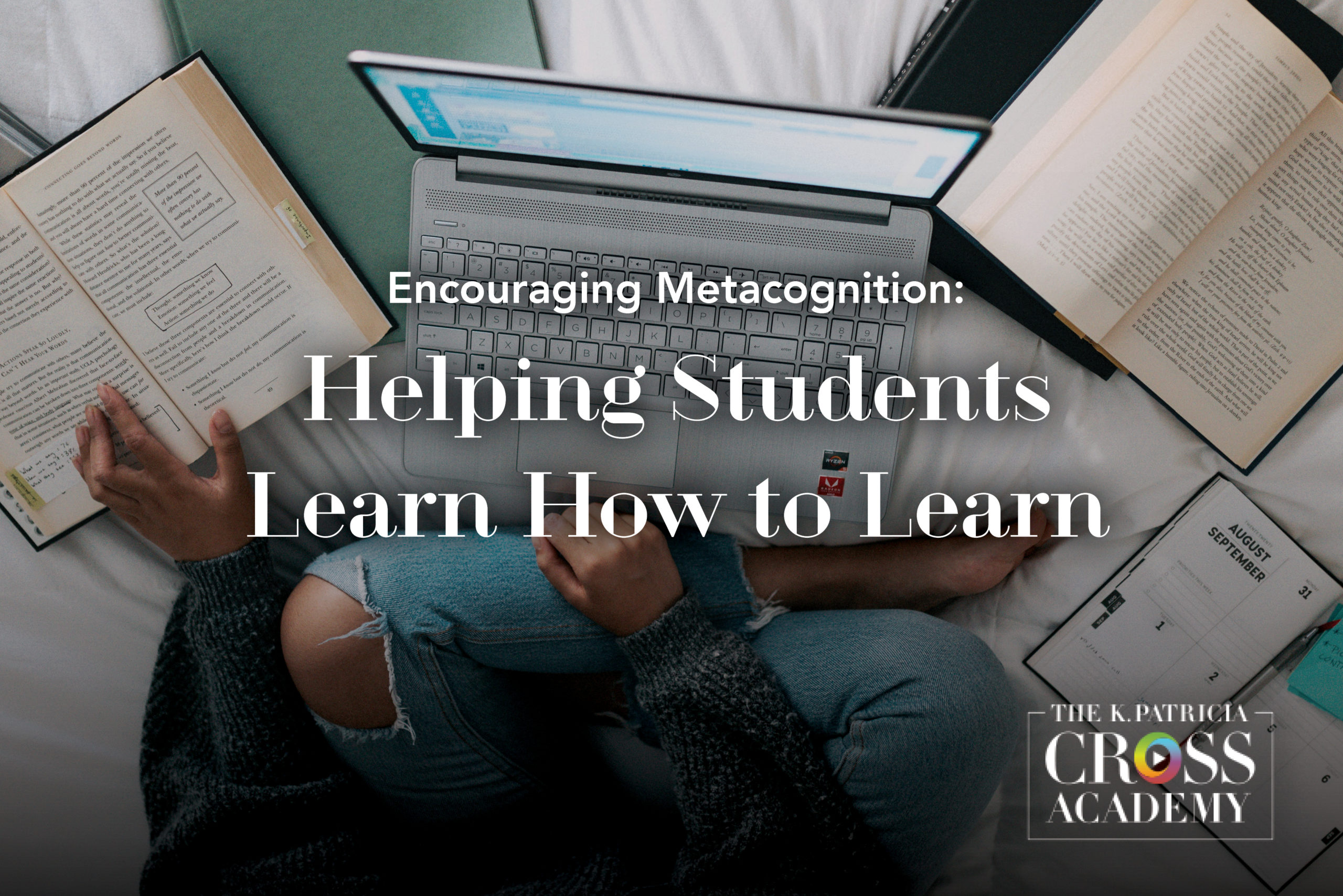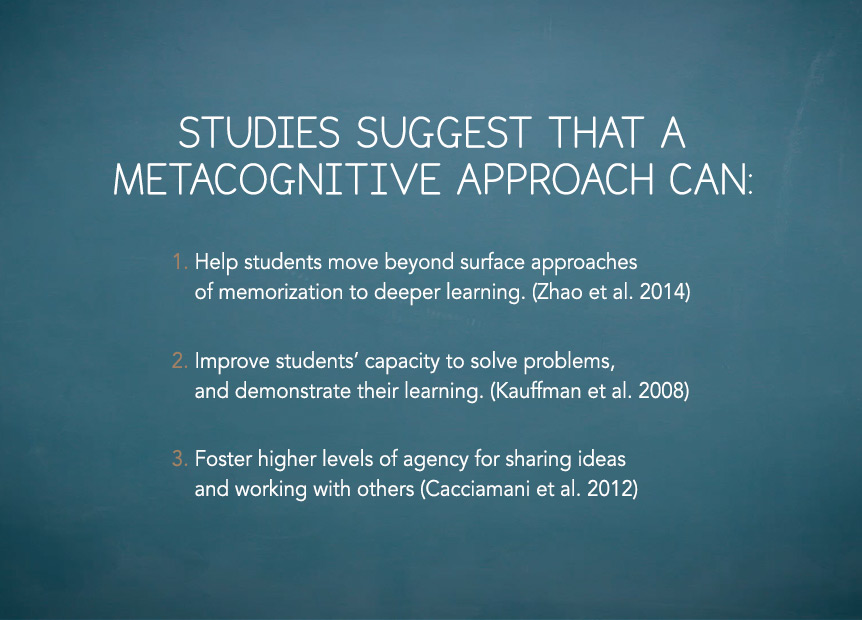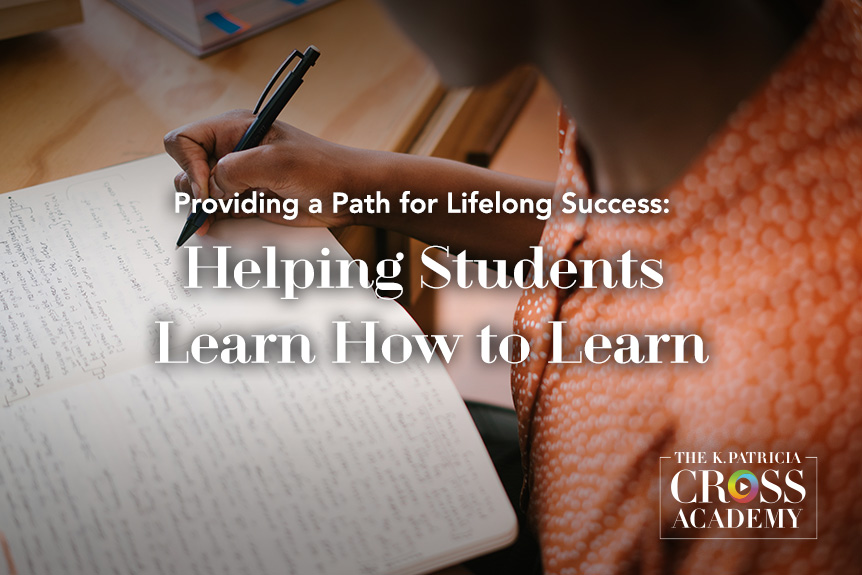
College and university students are regularly asked to learn a great deal of content and many skills in their courses, but the learning processes involved are rarely considered or managed on their own. For example, students can find it incredibly difficult to recognize learning gaps or misunderstandings when learning a new concept or process. They don’t always plan out their learning or reflect on how or how well they have learned. Students need to know about learning processes – and practice them – to be effective, efficient learners.
What is Metacognition?
Students who do know how to learn and how to manage their own learning are typically more successful in academic settings and beyond. The formal term for “learning how to learn” is metacognition, which can also be defined as “thinking about thinking.” Metacognition specifically refers to the processes used for planning, monitoring, and assessing one’s own understanding and performance. It also involves a critical awareness of one’s thinking and learning and of oneself as a thinker and learner.
Metacognition specifically refers to the processes used for planning, monitoring, and assessing one’s own understanding and performance.
Metacognitive activities can help guide students through the process of reflecting on what they have learned, comparing intended learning to actual outcomes, evaluating the efficacy of their own learning strategies, and synthesizing the meaning of not only what they have learned but also how well they learned it. In addition, Metacognitive activities guide students through the process of considering what they need to learn, comparing intended to actual outcomes, evaluating their cognitive strategies, and synthesizing the meaning of not only what they have learned but also how well they did in the learning processes.
In theory, there are many advantages to using metacognitive activities. When students are asked to intentionally engage in metacognitive activities, they strive to overtly make meaning from their experiences, which solidifies learning. These activities encourage students to produce personal insight and connect it to their learning, which tends to deepen it. Learners who apply metacognitive practices typically are also better able to transfer and apply their learning in new contexts and situations, which extends and also improves learning. In short, when we build in these metacognitive activities, we are teaching students how to learn.
In addition, metacognitive activities often provide valuable information that can allow for assessment not only of student knowledge but also their metacognitive processes. Many of these activities can be done outside of class, which can make them a time-efficient way to gather information about and improve student learning.

Research on Metacognition and Student Learning
But does asking students to think about and reflect upon their learning really work? There is a growing body of evidence to suggest that it does. How People Learn is a synthesis of decades of research findings related to the science of learning completed for the National Academy of Sciences. One of the three main findings highlighted in this important synthesis is the effectiveness of a metacognitive approach to instruction (Bransford, et al, 1999). Consider the following findings from studies since Bransford et al’s groundbreaking work:
- Zhao et al. (2014) documented that metacognitive activities helped students move beyond surface approaches of memorization to deeper learning.
- Kauffman et al. (2008) examined how self-reflection improved students’ capacity to solve problems and found that students who received the problem-solving process prompts wrote with more clarity and better demonstrated their learning than those who did not.
- Cacciamani et al. (2012) found that ample opportunities for metacognitive reflection in an online class fostered higher levels of agency for sharing ideas and working with others.
The growing body of research supports that metacognition improves student learning.

Techniques to Encourage Metacognition
Students don’t come to our courses knowing how to engage in metacognitive processes. It is important, then, to intentionally and explicitly weave these strategies into our teaching and learning activities. Students who participate in metacognitive reflection typically engage in one or more of the following activities:
- Making connections to prior learning
- Clarifying what they are to learn
- Planning their learning
- Documenting their learning
- Actively recalling what they have learned
- Identifying successes and failure in learning
- Identifying areas for improvement and growth.
See the following Cross Academy videos for specific ways to encourage metacognition in your courses:
3-2-1: In the 3-2-1 technique, students have the opportunity to think about what they have learned and what they still need to know. They write about 3 things they learned, 2 things they found particularly interesting, and 1 question they still have about the content.
View main video here: View Technique →
View online adaptation here:
Lecture Wrapper: A Lecture Wrapper is a tool for teaching students to self-monitor their behavior as they identify key points from a lecture and then compare their points to the instructor’s list of points.
View main video here: View Technique →
View online adaptation here:
Post-Test Analysis: A Post-Test Analysis is a two-stage process that is divided into several steps designed to help students develop greater awareness of their test-preparing and test-taking skills.
View main video here: View Technique →
View online adaptation here:
Metacognition is one of the most important and least used approaches for improving student learning in college and university courses. We, teachers, can help students learn how to learn, and when we do so, it serves students in our courses and beyond. We encourage you to try out some of the above techniques in your own courses.
Enter your email below to receive information about new blog posts.
References
Bransford, J., Donovan, M., & Pellegrino, J. (1999). How people learn: Bridging research and practice. Washington, DC: National Academy Press.
Cacciamani, S., Cesareni, D., Martini, F., Ferrini, T., & Fujita, N. (2012). Influence of participation, facilitator styles, and metacognitive reflection on knowledge building in online university courses. Computers & Education, 58(3), 874-884.
Kauffman, D. F., Ge, X., Xie, K., & Chen, C.-H. (2008). Prompting in Web-based environments: Supporting self-monitoring and problem-solving skills in college students. Journal of Teacher Education, 35(2), 179-197.
Zhao, N., Wardeska, J. G., McGuire, S. Y., & Cook, E. (2014). Metacognition: An effective tool to promote success in college science learning. Journal of College Science Teaching, 43(4), 48-54.
Suggested Citation
Barkley, E. F., & Major, C. H. (n.d.). Encouraging metacognition: Helping students learn how to learn. CrossCurrents. https://kpcrossacademy.org/encouraging-metacognition-helping-students-learn-how-to-learn/

Engaged Teaching
A Handbook for College Faculty
Available now, Engaged Teaching: A Handbook for College Faculty provides college faculty with a dynamic model of what it means to be an engaged teacher and offers practical strategies and techniques for putting the model into practice.





